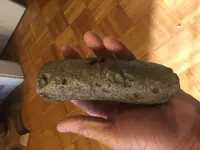You are using an out of date browser. It may not display this or other websites correctly.
You should upgrade or use an alternative browser.
You should upgrade or use an alternative browser.
Mammoth or Mastodan Tusk?
- Thread starter Billco
- Start date
Kray Gelder
Gold Member
- Joined
- Feb 24, 2017
- Messages
- 7,005
- Reaction score
- 12,558
- Golden Thread
- 0
- Location
- Georgetown, SC
- Detector(s) used
- Fisher F75
- Primary Interest:
- Metal Detecting
Interesting. If it is a tusk, you should be able to scratch through the crust and find ivory.
CaptEsteban
Bronze Member
Looks like it to me ! YEAH !
Carolina Tom
Gold Member
Show us a pic of the end face please.
Looks good.
Looks good.
- Joined
- Mar 2, 2018
- Messages
- 7,222
- Reaction score
- 22,770
- Golden Thread
- 0
- Location
- Todds Point, IL
- Primary Interest:
- Metal Detecting
Mammoth ivory has fine criss-cross lines when polished and viewed from the end. These are called Schrager lines. Gary
diggummup
Platinum Member
- Joined
- Jul 15, 2004
- Messages
- 17,824
- Reaction score
- 10,135
- Golden Thread
- 0
- Location
- Somewhere in the woods
- Detector(s) used
- Whites M6
- Primary Interest:
- All Treasure Hunting
Looks more bone than ivory to me also.
PaleoCris
Jr. Member
The holes in this rib section is the result of boring clams (Pholadidea). Their bore holes are very commonly found on dugong rib sections, but I have never seen them on ivory. You can differentiate the ribs of other marine mammals like porpoises and whales from dugongs due to the density of the bone, which helps weigh down the dugong, allowing it to dive rather than float constantly as it would if it's bones were not solid. The same goes for manatees.
Dugong bones are solid, often times have clam bore holes, and will have growth rings (more like a series of half circles) on the broken cross-section (but not the crosshatching seen in ivory).
Dugong bones are solid, often times have clam bore holes, and will have growth rings (more like a series of half circles) on the broken cross-section (but not the crosshatching seen in ivory).
Similar threads
- Replies
- 11
- Views
- 1K
Users who are viewing this thread
Total: 1 (members: 0, guests: 1)





